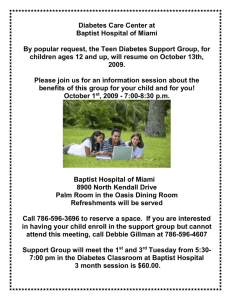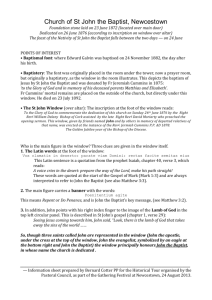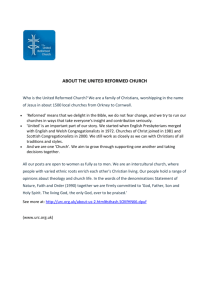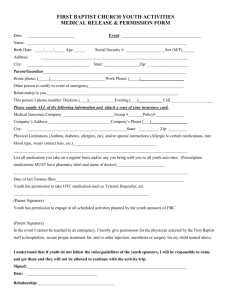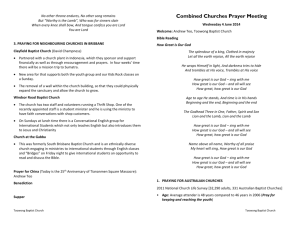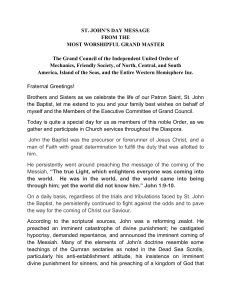The History of the Dutch Baptist Churches
advertisement
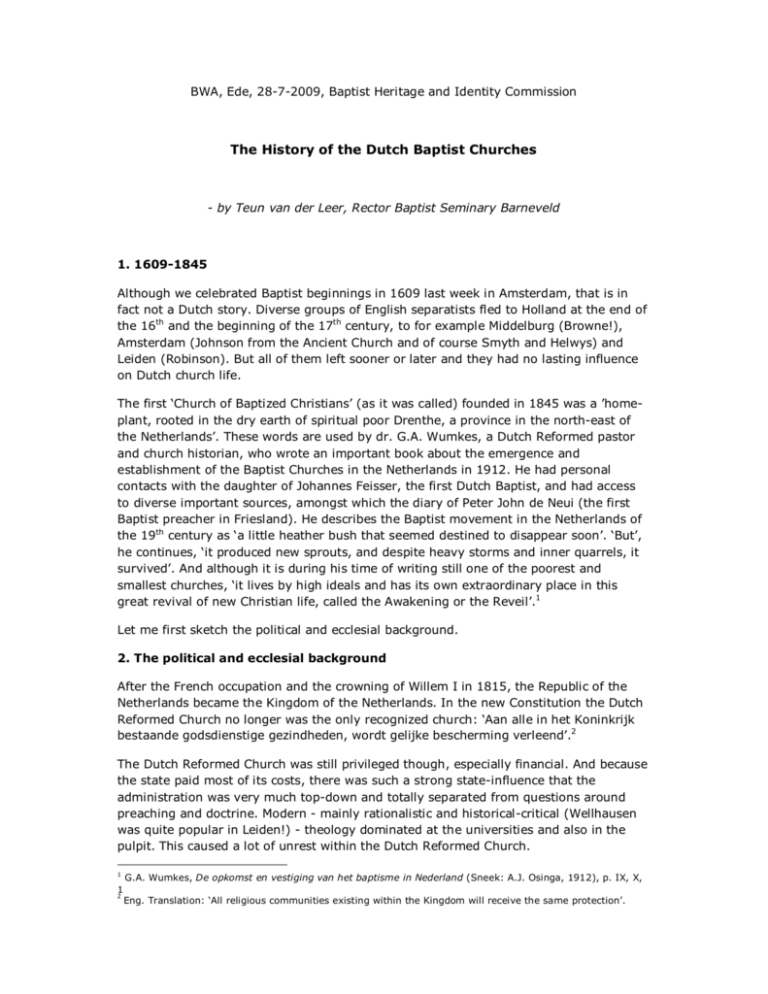
BWA, Ede, 28-7-2009, Baptist Heritage and Identity Commission The History of the Dutch Baptist Churches - by Teun van der Leer, Rector Baptist Seminary Barneveld 1. 1609-1845 Although we celebrated Baptist beginnings in 1609 last week in Amsterdam, that is in fact not a Dutch story. Diverse groups of English separatists fled to Holland at the end of the 16th and the beginning of the 17th century, to for example Middelburg (Browne!), Amsterdam (Johnson from the Ancient Church and of course Smyth and Helwys) and Leiden (Robinson). But all of them left sooner or later and they had no lasting influence on Dutch church life. The first ‘Church of Baptized Christians’ (as it was called) founded in 1845 was a ’homeplant, rooted in the dry earth of spiritual poor Drenthe, a province in the north-east of the Netherlands’. These words are used by dr. G.A. Wumkes, a Dutch Reformed pastor and church historian, who wrote an important book about the emergence and establishment of the Baptist Churches in the Netherlands in 1912. He had personal contacts with the daughter of Johannes Feisser, the first Dutch Baptist, and had access to diverse important sources, amongst which the diary of Peter John de Neui (the first Baptist preacher in Friesland). He describes the Baptist movement in the Netherlands of the 19th century as ‘a little heather bush that seemed destined to disappear soon’. ‘But’, he continues, ‘it produced new sprouts, and despite heavy storms and inner quarrels, it survived’. And although it is during his time of writing still one of the poorest and smallest churches, ‘it lives by high ideals and has its own extraordinary place in this great revival of new Christian life, called the Awakening or the Reveil’.1 Let me first sketch the political and ecclesial background. 2. The political and ecclesial background After the French occupation and the crowning of Willem I in 1815, the Republic of the Netherlands became the Kingdom of the Netherlands. In the new Constitution the Dutch Reformed Church no longer was the only recognized church: ‘Aan alle in het Koninkrijk bestaande godsdienstige gezindheden, wordt gelijke bescherming verleend’.2 The Dutch Reformed Church was still privileged though, especially financial. And because the state paid most of its costs, there was such a strong state-influence that the administration was very much top-down and totally separated from questions around preaching and doctrine. Modern - mainly rationalistic and historical-critical (Wellhausen was quite popular in Leiden!) - theology dominated at the universities and also in the pulpit. This caused a lot of unrest within the Dutch Reformed Church. 1 G.A. Wumkes, De opkomst en vestiging van het baptisme in Nederland (Sneek: A.J. Osinga, 1912), p. IX, X, 1 2 Eng. Translation: ‘All religious communities existing within the Kingdom will receive the same protection’. Let me mention the two most important developments (reactions) in that regard, the Réveil and the Afscheiding (separation). The Réveil was an international revival movement, rooted in the Awakening. The French name derives from French speaking Geneva, where it started in 1816 through the well known Robert Haldane (who had become a Baptist in 1808). He started Biblestudy- and prayergroups and this phenomenon spread from Switzerland to many places in Europe and also to the Netherlands. In Switzerland the Réveil led to a Free Church (Eglise Libre): free from the state and free in membership. In the Netherlands it became a renewal movement within the Dutch Reformed and the Lutheran Church, more an ecclesiola in ecclesia. But it did open the minds and spirits of people for renewal and new ecclesial developments. The Réveil was orthodox and Calvinist, but its influence was more pietistic: personal piety, witness and social work. Many charitable initiatives in the 19th century are connected with the Réveil (for example ‘Tot heil des volks’3 in Amsterdam, work among alcoholics, drug addicts, homeless people and prostitutes). The Afscheiding (separation) was the result of this top-down policy and the lack of doctrinal restriction. In 1834 Hendrick de Cock, a Dutch Reformed pastor in Ulrum (Groningen) published an Acte van Afscheiding en Wederkeer (Act of Separation and Return) in which he justifies his separation of a false church, which is a return to the real reformed church of the Reformation, de Christelijke Afgescheiden Kerk (Christian Separated Church). Many churches follow. It is this separation that ‘breaks the ice of the frozen Dutch ecclesial waters’ and in its wake other smaller churches, among whom the Baptists, will follow.4 (though the Dutch Reformed Church tried to have it forbidden taking ‘existing’ literal for 1815 only!). The Afscheiding was the beginning of a long story of separated churches that all carry in some way the name ‘gereformeerd’ (reformed). For an overview, see the Power Point Presentation, slides 3 and 4.5 3 Eng. Translation: ‘For the benefit of the people’ The picture about the ice is from prof. dr. Olof de Vries. See his Gelovig gedoopt. 400 Jaar baptisme, 150 jaar in Nederland (Kampen: Kok, 2009), p. 84 5 In Dutch we have two words for reformed and two words for church, ‘hervormd’ and ‘gereformeerd’ and ‘kerk’ and ‘gemeente’, respectively. So although in the English language some names of different churches appear the same, in Dutch they are different. Also there is a difference in the use of ‘church’ and ‘churches’ in a denomination’s name. When it ends with ‘church’ it usually is more centrally organized with an emphasis on the national church, while ‘churches’ emphasizes the priority of the local church, tending a bit towards congregationalism. 4 3. Johannes Elias Feisser Feisser is ‘our’ John Smyth (sim)6. We call him the first Dutch Baptist. Born in 1810, he studies theology in Groningen and Leiden. He is a liberal theologian, who as a pastor emphasizes the ethical example of Jesus Christ. After a deep personal crisis (his wife and two of his children die and he himself looses the sight in one of his eyes) he resigns and returns to his parents home. During these years he is inspired by Puritan writers (sim), especially John Newton’s Cardiophonia (or the utterance of the heart). This meant a fundamental shift in his theology and his own faith. He became an orthodox Calvinist and returned to the pastorate in Gasselternijveen (Drenthe in the northeast). He soon was disappointed that he met so few ‘born again Christians’. In his writings during this period you can see that he more and more emphasizes the church as a church of visible saints, 6 From now on I’ll put a ‘(sim)’ at all the moments that we can see similarities between what happened in England around 1600 and what happened in the Netherlands around 1940: Puritan influence, separation from the state-church, discussion with other separatists who didn’t go far enough etc. predestined and born again and with visible signs of saving grace (sim). It came to a clash with his church board after several collisions around his refusals to baptize children of non-regenerated church members and his effort to exercise discipline around the Lord’s Table. He was fired on December 19, 1843, effective January 1, 1944 (they decided it before Christmas, but needed him during Christmas!). Some pastors from the Afscheiding expected him to join their cause, but after a meeting with some of them, he found them too rational (‘their faith is one foot too high’) and they found him too congregational and his baptism view unacceptable. He called the Afscheiding half work: they separated from the world and from the false church, but they missed what he called the aggregation of the visible saints in one body (sim). The cause for that he found in infant baptism: this made the church an inextricable mixture (corpus permixtum) of believers and nonbelievers. A Believers Church needs Believers Baptism. This became his conviction even before he made contact with the Baptists in Hamburg. He himself came to the conviction that a true Calvinist (who wants a pure church of visible saints) is a Baptist! In fact you can say that for Feisser the ecclesiola in ecclesia is the church! When Köbner (send by Oncken, who had received word about a Dutch Reformed minister who was fired because of his baptismal views) met with him in November 1844, Feisser discovered that the church he had formed in his mind (and heart!), already existed. After some correspondence, Köbner returned and baptized Feisser and 6 others on 15 May 1845 in a small water behind the farm of Roelof Reiling. After the baptism, Köbner ordained Feisser as pastor and Reiling as deacon and so the first ‘church of baptized christians’ was born. In their application to the crown to establish a Christian Separated Church, they mentioned as their confession the reformed one with the exception of the article on baptism (sim). They declared that they would abide by the words of the Lord Jesus and his apostles in a ‘healthy and simple way’. They assured that they were not after something new, but that they were eager for more than just knowledge (‘visible signs of saving grace’!). They wanted to live by faith and do this ‘sober, upright and godly, awaiting our blessed hope, the appearing of the glory of our great God and Saviour Jesus Christ’ (Titus 2:12-13)7. The group around them at that moment consisted of about 35 people, but because of the immediate resistance (for example the brothers Kruit had to leave the house they hired) it diminished to 15. When Feisser in a letter shows his disappointment about this to Oncken, he writes to him not to be discouraged, for ‘Die Wahrheit, die volle Wahrheit hat zu allen Zeiten dieselben Kämpfe zu bestehen gehabt (…). Die Taufwahrheit greift so tief in das Wesen aller Staatskirchen und anderer Kirchengemeinschaften ein die den Apostolischen Standpunt verlassen haben, dass wir nichts als den kräftigsten Widerstand erwarten dürfen. Indess je grösser der Widerstand je herrlicher der Sieg, den der Herr über alle Irthümer der Menschen davontragen wird. Ich muste hier bei meinem ersten Auftreten auch ganz dieselbe Erfahrung machen (…). Der Herr aber stand mir bei, und durch Seine Gnade ist dass Werk herrlich gediehen, gelobet sei Sein Name! Lassen Sie sich desshalb nicht entmutigen, denn darauf hat der Satan es angelegt’.8 4. Jan de Liefde Around the same time a young Mennonite pastor in Zutphen converted to orthodoxy, which changed his preaching and made a lot of his members attend the Dutch Reformed 7 8 Wumkes, p. 28 Wumkes, p. 346 Church and made many reformed people come to his chapel. He came to the conviction that his baptism (as an adult but by sprinkling) was no longer valid since he himself wasn’t born again at the time and his baptizer neither. He published about it and Feisser went to visit him already in the summer of 1844. They became close friends and Feisser expected him to be baptized with him by Köbner the next year. But De Liefde refused. He had two objections: that a German Baptist had to come to baptize them ‘smells after Romish succesionism’ (1) and that baptism means membership into the local church was for him not self-evident (2). He even called this sectarianism. In 1849 de Liefde was baptized in the Baptist Church of Amsterdam, but left it within three months. To make a long story short: De Liefde remained most of his life a traveling evangelist and later founded the Free Evangelical Churches, with the emphasis on free. He was a charismatic leader and is amongst other things also the founder of ‘Tot heil des volks’. 5. Two legs: pure church and evangelism In Feisser and De Liefde we not only have two leaders who influenced Dutch Baptist life, but also two types of baptistic faith and life, that can still be seen today and which have caused and still sometimes do cause tensions within our churches. I refer to them as the two legs of the Dutch Baptist Body: pure church and evangelism. Feisser represents the stream that emphasizes the importance of the local church as a body of visible believers. We are called to look for the pure church: born again believers who comfort, strengthen and correct one another (discipline!). He preferred a small pure church above large numbers. De Liefde represents the much more evangelistic part. He openly said he was more interested in saving souls then in building churches9. Behind these differences there is also the difference between Calvinism and Arminianism, or particular and general (sim). 9 In January 1849 he wrote to a friend: ‘I have prayed that the Lord in this year will lead all of his children out of the human denominations and unite them into his divine house, which is not of wood or stone. And I have prayed that he will save us from ever starting a new denomination again’. Wumkes, p. 78 Without the leaders having planned for it, history shows how these two visions worked together. De Liefde started a school for evangelists in Amsterdam and one of his students, Holleman, later started one in Leeuwarden (Friesland). Many of them became active within existing Baptist churches and some became Baptist pastors. Some groups of their converts later formed Baptist churches and some of the Free Evangelical Churches they founded, later became Baptist churches. Many times the evangelists in the beginning do not mind too much about the formation of a – what we would call today – ‘solid church’. But Baptist leaders as Kloekers10 and de Neui11 made sure that ‘the Baptist principle’ of closed membership and closed communion, was accepted. So the two legs are ‘visible church’ (inward looking) and evangelism (outward looking). 6. Baptist Union In 1881 seven churches founded a Baptist Union in Foxhol (Groningen). The leading men were Kloekers (first president), Reiling, Kruit, Lindeman, Horn, de Hart and van Beek. The purpose of the Union was (and still is!) ‘to advance among its members love, esteem and united cooperation’. At its first assembly a periodical was started 12 ‘to promote true Christianity, as it is revealed in the New Testament’. Looking back now on the Unions history we can discern five stages13: 10 A former missionary in China, who later married the widow Feisser A charismatic and emotional preacher from Hamburg (he used to preach ‘under tears’), who founded the Baptist Church in Franeker and started preaching stations in Makkum, Workum, Stavoren, Harlingen and Dokkum (all in Friesland), all of whom later developed to Baptist churches, after he had left for America in 1871 12 ‘De Christen’ which continued till 2004 13 See also De Vries, p. 164-321 11 1. The stage of antithesis over against the church-enemy, 1881-1910 Baptists found their identity mainly by emphasizing what they were not: not an institutional church, no hierarchy, no synod, no confessional church, not doctrinal, not liberal, no infant baptism. The following song by Rev. Van Beek in 1895 illustrates this stage (celebration 50 years of Dutch Baptist History): ‘Children of freedom, avoiding churchly proud and priestly rule, leaded by its Shepherd, the Head of his church, we are in Him as brothers, united by his Spirit’. (italics mine, TvdL) This song was deeply rooted in the Baptist soul. As a minority, still seen and treated as a sect, they found their identity in this avoidance. Van Beek: ‘Still we are many times objects of ridicule, despise and persecution, most of all from the side of ecclesiastic and religious people, who are eager for church and church doctrine’. For Baptists ‘the church’ embodied everything that blocked living faith and the spread of the gospel. Van Beek talks about being ‘bonded to a soul-killing church-idea’, which he defined with words as dead tradition, doctrine, coercion and power, but most of all with infant baptism: this was the root of all evil! 2. The stage of emancipation and a growing Baptist self-awareness, 1910-1940 In this period the Union grew to a national organisation with self-respect: 1913: ‘De Zaaier’, national evangelistic magazine 1923: Fellowship of Baptist Ministers 1925: Dutch Baptist Youth Movement 1929: Dutch Baptist Women Movement Leaders in these times were Rev. J.W. Weenink (inspirator and instigator), Rev. J. Louw (the theologian) and K. Reiling (the implementer). 3. The stage of ‘being a self-confident church among the churches’, 1940-1980 1948: Member of World Council of Churches (till 1963) ‘When our churches openly bring their witness and principle forward without fear, this can only mean profit. It gives the churches a more clear view on our essence and striving. And from our side we will be able to understand more clearly that many others are seriously striving to advance God’s work’. 1958: Baptist Seminary as a ‘scientific Bibleschool’ 1970: Covenant of the Seminary with the University of Utrecht 1973: Special Chair ‘History and Doctrine of Baptist Churches’ at University of Utrecht (since 2009 at Free University Amsterdam, working together with the faculty of theology, the Center of Evangelical and Reformation Theology and - in the near future with the Mennonite Seminary and the Azusa-faculty of the Pentecostal Churches) Leaders in this period are prof. dr. J. Reiling (the theologian) Jan van Dam (the organiser) and Rev. Jaap Broertjes (the pastor). 4. The stage of polarisation, 1980-1990 The whole emancipation and especially the theological emancipation did release resistance and suspicion. In the eighties a group of 12 Baptist ministers gathered, most of whom had not grown up within the Union. They were worried what they perceived as Bible-critical teaching at the university and the seminary. They started a so-called ‘Evangelical Consideration’, and after some open letters and (dissatisfying) talks with the seminary and the Union-board, they published the ‘Information folder with foundation’ and send it to all the local churches. In it they speak of their ‘deep concern in regard to developments within the Union’ and their passion ‘to obey Gods Word alone’. They emphasize that the Bible not just contains or includes the Word of God, but is the Word of God. Bible criticism should not be taught at the seminary for it rests upon ‘the pride of the human heart and mind’. The seminary should correct the teachings of the university! In reaction the foundation ‘Friends of the Seminary’ was formed, to collect extra funds for the seminary, and the so-called movement ‘Space’ was formed, in which people united who felt set aside in their local churches, especially women and homosexuals. The movement published a newsletter for encouragement and open(!) discussion and organised ‘days of exchange and encouragement’. All this fuelled the polarisation, and in 1986 Theo van der Laan resigned as a teacher and became a Mennonite minister, and prof. Reiling resigned as rector. The only remaining teacher dr. Olof de Vries was appointed rector and later became professor on the Special Chair. Rev. Yme Horjus replaced Theo van der Laan. Strangely enough the policy of the seminary did not change. The only new thing was that Yme Horjus introduced Church Development in the curriculum. In the nineties other things attracted the attention of the Baptists. 5. The stage of evangelicalism, 1990-now In the seventies and eighties the evangelical movement had its breakthrough in the Netherlands and it didn’t pass the Baptist churches: - liturgical renewal: Global Praise & Worship, music bands, drama, prayer ministry - Church Development programmes like NCD14, Willow Creek and Purpose Driven were introduced and used in many churches - Churches started using Youth for Christ-programmes for their youthwork like Rock Solid and Solid Friends instead of their Baptist programmes - The Alpha-course and Marriage-course were introduced and used in many churches The growing churches within the Union right now are the more evangelical churches in the middle and the west of the country, while the more traditional ones (familychurches, organised according to the association model, in fact a model of Baptist pillarisation 15) are declining. In 2002 a large reorganisation was established in which the word ‘integration’ played a key role. The five task forces (Theological Education, Church Development & Evangelism, Youth Work, Women’s Work, Mission & Social Work) have each a representative in the board and in the staff en make their policy together. For the period of 2008-2012 the Union has three spearheads: Church Development, Mutual Solidarity and Church Planting. The seminary doubled its students since 2005 from 20 to 40 and seeks more and more cooperation with other institutions, national and international. 7. Reflection The history of the Baptists in the Netherlands is still quite short. The church is still a small one within a dominant reformed climate. At the same time evangelicalism is conquering field and Baptists can be flexible enough to gain from it. The staff of the Union, and of the seminary primarily, increasingly presents itself within this field with confidence, knowing that she has something to contribute in the area of ecclesiology, the Achilles' heel of evangelicalism (an evangelical ecclesiology is as you know ‘an oxymoron’16). Through the research program Mapping Baptist Identity that will be developed at the Free University in the coming years, the Dutch Baptists hope to put themselves on the map and make churches and movements aware of their contribution. Research done by myself for an ‘ecclesial minimum’ was and is still heavenly discussed on the internet and an article on the Believers Church Tradition will be published and discussed in a Reformed Theological Journal at the end of this year.17 In this time of transformation and new expressions of (emerging) church, I think Baptist theology can contribute a lot. Prof. de Vries writes in his book on our history that Baptists are sensitive to spiritual alternatives in the need of the day. At the end of the 19th century we had a Dutch Baptist Church of local closed membership and closed communion churches, with a passion for revival and evangelism and with a high value of 14 National Church Development program from Christian Schwartz For example in 1940 the Baptist Church of Groningen had an association for men, women, young men, young women, boys, girls, choir, fanfare, mandolin club, sundayschool 16 See Bruce Hindmarsh, “Is Evangelical Ecclesiology an Oxymoron? A Historical Perspective”, in John G. Stackhouse Jr., Evangelical Ecclesiology, Reality or Illusion? (Grand Rapids: Baker Academic, 2003), p. 15-37 17 It is already published in English in the Journal of European Baptist Studies Vol. 9 No. 3, May 2009: Teun van der Leer, Which future Church (form)? A plea for a ‘Believers Church’ ecclesiology, p. 40-51 15 the autonomy of the local church. Theologically the choice was made for a universal gospel over against the predestination Calvinism of Feisser and de Neui. In the following history there is an external and an internal aspect that influences the choices and developments:18 External: sensitive to its own time, resulting in either adaptation or rejection and offering a non-conformist alternative (for example openness for revivalism, but rejection of the ecumenical movement in the sixties) Internal: going back and forth between ‘movement’ and ‘church’. This does not lead to a ‘middle position’ which is standing still. It means always being ‘on the move’, discerning the will of Christ ‘for the day’. 19 And that is what we, God willing, will continue to do. 18 For more on this see De Vries, p. 22-27 and 164vv. See how I quoted prof. Verkuyl on this at Amsterdam 400: ‘Prof. Johannes Verkuyl, the missiologist of the Free University here in Amsterdam in the seventies and the eighties of the twentieth century, wrote about Matthew 28: ‘When Jesus promises: And lo, I am with you always (in Dutch more literally translated as: every day, the Greek text uses tas hèmeras), then it is our responsibility to ask ourselves: and what day is it today? What are we called to as a church in this particular time and in this particular situation? What is “das Gebot der Stunde”, the command of the hour’? 19
